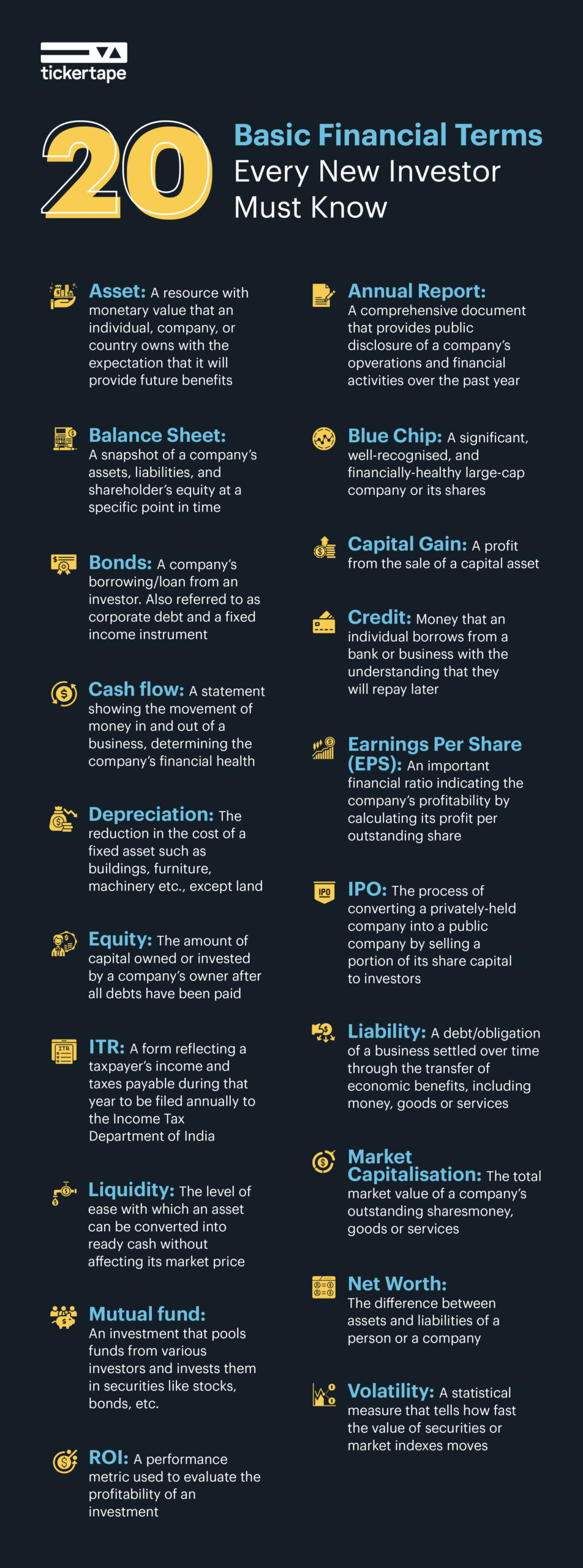Last Updated on Aug 1, 2022 by Vyshakh
Asset, capital gain, liability, liquidity, ROI…
Did your mind go blank while reading these terms?
There are numerous financial terminologies like these that might strike in your day-to-day life. Not knowing them might create a dent in your finances. So, begin by learning the below-mentioned 20 terms to get your ride in the financial world started.
Table of Contents
20 financial terms you must know
From basic terms like an asset, balance sheet and credit to advanced ones like cash flow and earnings per share, here’s a brief on essential terminologies a new investor should be aware of.

1. Asset
Assets are simply a resource with a monetary value that a company owns. They are meant to provide future benefits to the business. Assets are created or bought to increase the company’s value or benefit its operations.
You can also understand them as something that may generate cash flow, enhance sales, or reduce expenses. Assets are reported on a company’s financial statements. They are broadly classified into two categories:
- Current assets: They are short-term economic resources. It is expected that they will either get consumed or converted into cash within a year. Examples of current assets are cash, prepaid expenses, inventory, accounts receivable, and marketable securities.
- Non-current assets: They are long-term economic resources that are expected to be productive for the business for more than a year. Examples of non-current assets include tangible fixed assets (buildings, equipment, furniture, land), intangible fixed assets (patents, copyrights, and trademarks), goodwill, and investments.
2. Annual Report
An annual report is a comprehensive document that a company must provide to all its shareholders annually. It describes their operations throughout the year and their financial health. The intent of a company’s annual report is to provide public disclosure of its operations and financial activities over the past year.
The annual report usually contains the following:
- A letter to shareholders from the president or CEO
- General corporate information
- Financial highlights of the year
- Operations that have been carried out in the past year
- Management’s discussions and analysis
- Financial statements
- Summary of financial data
- Policies
Apart from shareholders, the annual report is available to employees and customers as well.
3. Balance sheet
There are three fundamental financial statements: income statement, cash flow statement, and balance sheet. They are intricately related to each other. A balance sheet provides a snapshot of a company’s assets, liabilities, and shareholder’s equity at a specific point in time. (We will learn liabilities and equity further in this article)
A balance sheet should always balance, hence the name. The assets should always equal the liabilities and shareholder equity. If they are not balanced, there may be some issues, including incorrect or misplaced data, miscalculations, or exchange rate or inventory errors. Hence, in a balance sheet,
Assets = Liabilities + Shareholders’ Equity
All in all, balance sheets tell what a company owns, what it owes, and what it is worth as a company.
4. Blue-chip
The term ‘blue chip’ is used to represent a significant and well-recognised company or its shares. Blue-chip companies are known to have a history of sound financial performance. The stocks of blue-chip companies can endure tough market conditions and provide high returns in good market conditions.
Blue-chip stocks are considered less volatile investments and favourable for long-term financial goals. So, if you are looking for investment instruments that offer consistent returns with low risk for your long-term goals, blue-chip stocks can be your best bet.
5. Bonds
In simple words, a bond is a company’s borrowing/loan from an investor. The borrower (company) utilises the money for its operations, while the investor receives interest on the investment. Bonds are also referred to as corporate debt (something that a company owes) and fixed income instruments.
Corporations and governments at all levels use bonds to borrow money. Notably, the market allows a lender/investor to sell the bond that they hold to another lender. The advantages of a bond are fixed returns, lower risk and volatility than stocks, and tax benefits. Conversely, the disadvantages of a bond include large investment requirements, low liquidity compared to stocks, and other risks such as credit risk and inflation risk.
6. Capital gain
Simply put, capital gains refer to the increase in value of a capital asset when it is sold. They arise when you sell an asset or investment for more than what you originally paid. Capital gains are applied to any type of asset, including investments.
The question is, do you have to pay tax on your capital gains? Well, the answer depends. Short Term Capital Gains (STCG) are taxed at your regular slab rate. Conversely, Long-Term Capital Gains (LTCG) are usually taxed at a lower rate.
7. Cash flow
As the name suggests, cash flow is a statement that shows the movement of money in and out of a business. Receipt of cash signifies inflows, while cash spent refers to outflows. The term cash flow also describes the amount of money generated or consumed in a given time period. It answers, ‘Where did the cash go?’ for your business.
A cash-flow statement determines a company’s financial health. A positive cash flow indicates that your company’s assets are growing from where you have started. In contrast, a negative cash flow indicates otherwise. Keeping track of your cash flows is important because they gives you insights into your business operations and whether you are leading towards your goals or not.
8. Credit
The term credit has many meanings in the financial world. Generally, it is a contract agreement between a lender and a borrower. The borrower receives money or something of value and repays the lender at a later date. It may or may not include interest charged on the borrowed amount. Credit enables you/the company to buy things you need now and pay for them over time.
Does this mean everybody gets the credit from a regulated lender? Well, it depends on the individual’s creditworthiness, often measured in terms of a credit score. It is essential to maintain a good credit score because, along with the lender, everyone from your landlord to insurance companies will check your credit score. It tells them about your financial health. Hence, maintaining a good credit score is essential and beneficial.
9. Depreciation
Depreciation refers to the reduction in the cost of a fixed asset. Examples of fixed assets are buildings, furniture, machinery, equipment, etc. Land is the only exception as its value always appreciates with time. Depreciation is a crucial factor to consider for tax and accounting purposes. It doesn’t actually represent a cash outflow.
To calculate the depreciation of any asset, you need three main inputs:
- Useful life – Time period over which the asset is useful to the company.
- Salvage value – Resale value of the asset a company might decide to sell the asset at a lower price.
- Cost of the asset – It includes taxes, set-up expenses, and shipping.
10. Earnings per share
A share represents a unit of equity ownership in a company. Earnings Per Share (EPS) refers to the company’s profit per outstanding share of the company. It is one of the important financial ratios that indicate the company’s profitability by showing how much money they make for each share of its stock.
Formula to calculate EPS:
EPS = (net income after tax)/(total number of outstanding shares)
A higher EPS signifies more profitability. EPS also helps in keeping track of a company’s past performances.
11. Equity
Simply put, equity is the amount of capital owned or invested by the company’s owner. It is the residual claim of the company owner after debts have been paid. Equity is commonly referred to as shareholders’ equity. To calculate equity, you need a company’s assets and liabilities.
Let’s consider an example: Company XYZ has total assets worth Rs. 80,30,000 and total liabilities of Rs. 20,00,000. Therefore, equity for Company XYZ will be,
Equity = total assets – total liabilities = 80,30,000 – 20,00,000 = Rs. 60,30,000.
12. IPO
Have you ever heard that a company is going public? It simply means they are launching their IPO. An Initial Public Offering (IPO) is the process of converting a privately-held company into a public company. For this purpose, the company sells a portion of its share capital to investors.
Once the IPO is done, the shares of the firm are listed and available to be traded freely in the open market. As an investor, you need to bid while applying for the shares in an IPO. A price range is decided, and the allotment of shares depends on the responses received from the investors on IPO.
13. ITR
Every individual of India has to pay the tax on their income to the Government of India as per the rules and regulations. Income Tax Return (ITR) is a form that a person files annually to the Income Tax Department of India. It reflects their income and taxes payable during that year.
The income you earn can be from numerous sources, including your salary, profits in business, sale of a property, capital gains, and interest received. The tax is applied to all these income sources. You can fill the ITR through online mode for a particular financial year, i.e. starting from 1 April of the previous year to 31 March of the current year.
14. Liability
Liabilities are what a company owes or has borrowed. They are financial obligations that usually require future sacrifices of economic benefit to another company or person.
With the information about a company’s liabilities, you can identify its overall liquidity and capital structure. The primary classification of liabilities is based on their due date, such as:
- Current liabilities: They are due within a year. They mainly include unpaid bills, interest expenses, short-term loans, income tax amounts, and more.
- Long-term liabilities: Their due time is more than a year. They consist of outstanding bonds, long-term debt, mortgages, and more. (We will learn liquidity and mortgage further in this article)
There is one more category of liability known as contingent liability, which may or may not arise depending on the outcome of an uncertain future event such as legal proceedings.
15. Liquidity
Liquidity refers to the level of ease with which you can convert an asset into ready cash without affecting its market price. The most liquid of all assets is cash. When the liquidity of any asset is high, it means that it can be easily converted to cash for the market price. Conversely, if the asset has low liquidity, it signifies difficulty in the conversion of the asset into cash.
Liquidity position compares an entity’s assets against its liabilities. With this information, you can identify if the company is solvent, i.e. if it can meet its long-term debts and other financial obligations. If the company’s total assets are higher than liabilities, it shows that it can pay its debt while having enough working capital left.
16. Market capitalisation
Market capitalisation, commonly referred to as a market cap, is the total market value of a company’s outstanding shares of stock. It is one of the most effective ways of evaluating the value of a company. The point to note here is that you can only evaluate companies that are publicly listed.
To calculate the market capitalisation of any company, you need to know the number of outstanding shares and the closing price of each share. Gather the information and put them in the following formula:
Market cap = (Number of outstanding shares) x (Closing price of each share)
For instance, the outstanding number of shares of a company is 10,000, and the closing price of the share is Rs. 88. Then,
Market cap of the company = 10,000 x 88 = Rs. 8,80,000.
Based on the market capitalisation, there are three different types of stocks,
- Small-cap stocks: Market cap up to Rs. 500 cr.
- Mid-cap stocks: Market cap from Rs. 500 cr to Rs. 7000 cr.
- Large-cap stocks: Market cap from Rs. 7,000 cr and higher, usually up to Rs. 20,000 cr.
17. Mutual Funds
A mutual fund is a pool of money that is collected and managed by a fund manager. It is a financial vehicle that puts together assets from the shareholders and invests them further in securities like stocks, bonds, and other assets. Mutual funds give individuals, and small/retail investors access to professionally managed portfolios of equity, bond, and other securities.
There are a plethora of mutual funds available in the market. They are divided into numerous categories, depending on various factors such as market capitalization, underlying asset class, and so on. Based on the market cap, these can be small-cap, mid-cap and large-cap funds. Mutual funds are usually considered safe investments and said to provide high returns in the long term.
18. Net worth
Who is the wealthiest person on this planet, and what decides that? Well, the net worth of Elon Musk is $215.6 bn, declaring him the wealthiest person on this planet. Net worth is the difference between the assets and liabilities of a person or a company. It gives a snapshot of your financial health.
If you have a positive net worth, your assets are higher than your liabilities, indicating good financial health. Conversely, if your net worth is negative, your liabilities are more than your assets. There are various ways to increase your net worth, such as amplifying your emergency fund. It will help you avoid the debt cycle, reducing your liabilities and increasing your net worth.
19. ROI
Return on Investment (ROI) is a performance metric used to evaluate the profitability of an investment. It determines how well an investment has performed. ROI is expressed as a percentage. If the calculations are positive, it means the business/investment ROI measured is profitable. Conversely, if the ROI is negative, it means the entity owes more money than what they are earning.
To calculate ROI, you need to know the net income and total cost of the investment.
ROI = (Net income / Cost of investment) x 100
There is one more way to calculate ROI, which is,
ROI = [{ (Money gained – Money spent)} / Money spent] x 100
The primary reason to calculate ROI is simply to gain insights into where you should be spending your money. It will enhance your future plans. Further, it will help you in selecting your investments.
20. Volatility
Volatility is a statistical measure that refers to the rate at which the price of a security increases or decreases for a given set of returns. Simply put, it tells you how fast the value of securities or market indexes moves. Securities mainly include stocks, bonds, mutual funds, warrants, and more. The term market indexes mean an index that tracks the performance of a group of stocks, bonds, or other investments such as Nifty50, Nifty500, and more.
Coming back to volatility, it can also be considered a measure of short-term uncertainty. Volatility is simply a measure of how big the price swings in the market are. It is necessary to understand the volatility of the market you have invested in to get better insights into the risks involved.
To sum up
Congratulations on taking the first step into the financial world. Learning everything about the financial world takes time. Start reading more articles and stay updated with the latest news in the market with Blog by Tickertape. Once you clear the basics, you can use Tickertape’s tools to research markets and invest. It is always worthwhile to take advice from your financial advisor before investing.
- Top 10 High-Return Mutual Funds in India (2024) - Nov 19, 2024
- Where to Invest Money in India? 15 Investment Options to Explore - Nov 18, 2024
- Best Long Term Stocks to Buy in NSE India for 2024 - Nov 18, 2024




